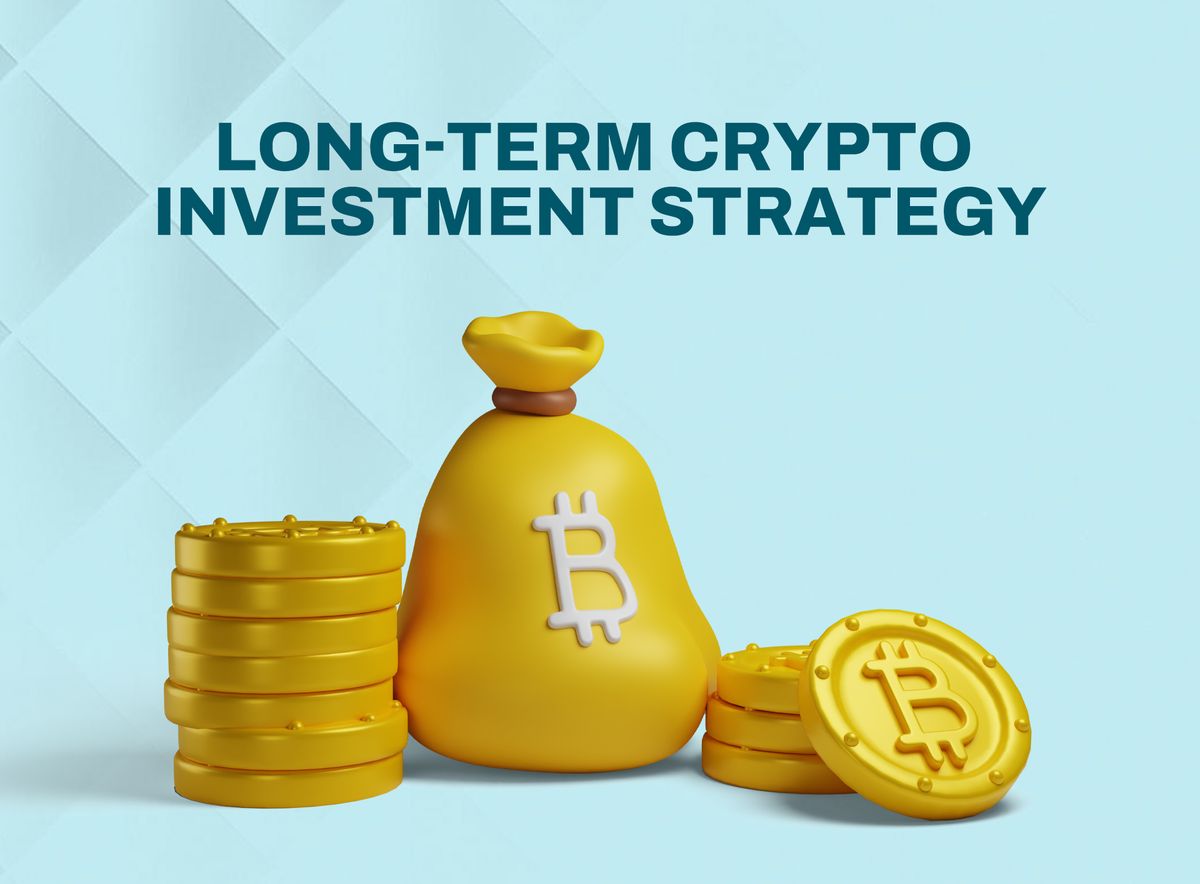What is the Best Long-Term Crypto Investment Strategy?
Want to invest in crypto for the long run? Discover the best strategies for building a strong portfolio, managing risk, and maximizing returns over time.

TABLE OF CONTENTS:
1. Understanding Long-Term Crypto Investment
2. Factors for Consideration for Long-Term Crypto Investment
3. Best Long-Term Investment Strategies
4. Investing in Established Cryptocurrencies
5. FAQs
6. Closing Thoughts
Cryptocurrencies have become a hot topic in the world of finance, drawing the interest of both experienced investors and newcomers.
As the market continues to evolve and gain momentum, people are exploring opportunities for long-term investment strategies in the crypto space. If you're wondering how to navigate these waters, let's explore some key insights and strategies to help you make informed decisions for the long haul.
Understanding Long-Term Crypto Investment
Investing in cryptocurrencies for the long term involves the strategic acquisition and holding of digital assets over an extended period. Unlike short-term trading, long-term investment focuses on weathering market fluctuations and potential instability, with the goal of generating substantial returns over years rather than days or weeks.
Factors for Consideration in Long-Term Crypto Investment
Research and Due Diligence:
Before diving into the crypto market, conduct thorough research. Understand the technology behind various cryptocurrencies, their use cases, the teams behind the projects, and their potential for real-world applications. Look for reliable sources, read whitepaper, and stay updated on market trends.
Diversification:
Diversifying your investment portfolio is a fundamental strategy for reducing risk. Allocate your funds across different cryptocurrencies to spread risk and increase the potential for long-term gains. Consider investing in a mix of established cryptocurrencies and promising new projects with potential.
Risk Management:
As with any investment, consider your risk tolerance. Cryptocurrencies are known for their instability. Establish a risk management strategy that aligns with your financial goals and capacity to tolerate market fluctuations. Avoid investing money you can't afford to lose, and consider seeking advice from financial professionals.
Time Horizon:
Long-term investment demands patience. Set realistic and achievable goals while understanding that significant gains might take time. Determine your investment horizon and be prepared for potential market cycles and fluctuations that may occur over the years.
Best Long-Term Investment Strategies
HODL (Hold on for Dear Life):
HODLing involves buying and holding onto a cryptocurrency for an extended period, regardless of market fluctuations. The HODL strategy is based on the belief that the long-term prospects of a cryptocurrency will result in significant appreciation over time. This approach requires patience and a strong belief in the technology and the project's potential.
Here’s how to practically HODL crypto:
1. Start by comprehending the fundamentals of cryptocurrencies. Bitcoin and Ethereum are commonly known, but there are many others, each with its unique purpose and technology.
2. Investigate different cryptocurrencies, considering their utility, technology, and long-term potential. Look for robust projects with solid use cases and active communities.
3. Spread your investments across various cryptocurrencies to reduce risk. Diversification can shield your portfolio from the instability of a single asset.
4. Invest only what you can afford to lose without affecting your financial stability or mental peace.
5. Stay informed about the market trends, technological advancements, and news related to the cryptocurrencies you've invested in.
6. Store your crypto in secure wallets, such as hardware wallets or reputable software wallets, like Obiex, ensuring protection from potential cyber threats.
8. Stick to your long-term strategy unless there are significant changes in the fundamentals of the cryptocurrency.
9. Review and reassess your portfolio periodically. While the strategy is to HODL, reassessing periodically helps in ensuring that your investment aligns with your long-term goals.
Dollar-Cost Averaging (DCA):
DCA involves investing a fixed amount of money at regular intervals, regardless of the asset's price. By consistently buying a specific cryptocurrency, you accumulate it over time, benefitting from both market highs and lows. This strategy reduces the impact of short-term market instability on your overall investment.
Here’s how to practically DCA crypto:
1. To start, pick a comfortable amount you're willing to invest regularly, let's say $100 each month.
2. Next, select a cryptocurrency or a few that you find promising or have done research on. For instance, Bitcoin or Ethereum could be initial considerations due to their widespread popularity and relatively stable positions in the market.
3. Once you have your selected amount and cryptocurrencies, set up a DCA plan with a crypto exchange or platform. Many exchanges offer automated investment options that allow you to buy your chosen crypto at regular intervals with your fixed amount.
4. Every month, your chosen amount, let's say $100, will automatically convert into the chosen cryptocurrency, regardless of the current price. For example, if this month's Bitcoin is $45,000 per coin, your $100 will get you a fraction of a Bitcoin; if next month it's $40,000, your $100 will buy slightly more Bitcoin.
Staking and Yield Farming:
Staking involves holding cryptocurrencies in a wallet to support the operations of a blockchain network. In return, you receive rewards, making it a passive income-generating strategy. Yield farming involves lending or locking up your crypto assets in decentralised finance (DeFi) protocols to earn interest or additional tokens. According to recent data from DappRadar, staking has been gaining traction, with over $16 billion locked in Ethereum 2.0 alone. Similarly, yield farming in DeFi protocols has seen exponential growth, with billions of dollars in Total Value Locked (TVL) across various platforms.
Let’s check out how to apply stake and yield farming in crypto:
1. Select a cryptocurrency that supports staking and yield farming. For instance, Ethereum (ETH) for staking, and platforms like Aave or Compound for yield farming.
2. Register on a trusted exchange platform that supports staking and yield farming. Securely set up a compatible wallet to hold your chosen cryptocurrency.
3. Transfer the selected cryptocurrency to your wallet. Follow the specific instructions on the platform to lock your tokens for staking. For example, staking ETH on Ethereum 2.0.
4. Transfer your cryptocurrency to a yield farming platform. Utilise the platform’s tools to provide liquidity, enabling you to earn additional tokens or interest.
5. Keep an eye on your staked assets and yield farming activities regularly. Reinvest the rewards or earnings back into staking or yield farming for compounding returns.
Investing in Established Cryptocurrencies
Consider investing in well-established cryptocurrencies with proven track records, strong use cases, and wide adoption. For example, Bitcoin (BTC), Ethereum (ETH), and other top-ranking cryptocurrencies have shown resilience and stability in the erratic crypto market.
Bitcoin, as the pioneer cryptocurrency, has steadily gained recognition and acceptance over the years. For instance, in 2021, Bitcoin's value surged to an all-time high of around $64,000, showcasing its potential for growth.
Similarly, Ethereum, recognised for its smart contract capabilities, serves as a platform for various decentralised applications and crypto projects. With a record high of over $4,000 in 2021 and $34,000 as of today, Ethereum's potential to innovate and adapt in the evolving market is evident.
Investing in these established cryptocurrencies is like acquiring digital gold or silver, with their market presence and reliability making them appealing choices for long-term investments.
Their established nature, substantial market capitalisation, and global recognition make them relatively safer investment options for individuals looking to enter the crypto space for the long haul.
FAQs
Q1. What is the best time to invest in cryptocurrencies for the long term?
A1: The best time is when you've done a thorough research and have a solid understanding of the market. Timing the market perfectly is challenging, but consistent investment over time is key.
Q2. Should I diversify my long-term crypto investment portfolio?
A2. Yes, diversification is a wise strategy to spread risk. Invest in a mix of established and promising new cryptocurrencies.
Q3. What are the risks involved in long-term crypto investment?
A3. Market instability, regulatory changes, and technological advancements are among the risks. It's crucial to stay informed and consider your risk tolerance.
Q4. How can I protect my long-term crypto investments from security threats?
A4. Use secure wallets, employ two-factor authentication, and avoid sharing sensitive information. Research and select reputable platforms for trading and storing your assets.
Q5. What role does patience play in long-term crypto investment?
A5. Patience is crucial as significant gains may take time. Long-term investing requires a long-term outlook and the ability to withstand market fluctuations.
Q6. Is dollar-cost averaging (DCA) suitable for long-term investment?
A6. DCA is a sound strategy for long-term investment as it helps reduce the impact of market instability by spreading out your investment over time.
Q7. How do I determine the right cryptocurrency for long-term investment?
A7. Consider factors such as the project's use case, the team behind it, community support, technological advancements, and overall market adoption.
Q8. What are the advantages of staking and yield farming in long-term investment?
A8. Staking and yield farming provide opportunities for passive income and offer rewards in the form of interest or additional tokens.
Q9. Can I change my long-term investment strategy if market conditions shift?
A9. Adapting your strategy to changing market conditions is reasonable. Being flexible and adjusting based on new information is a part of strategic investing.
Q10. How much should I invest in a long-term crypto strategy?
A10. Invest an amount you're comfortable with and can afford to hold for the long term. Determine your investment based on your financial situation and goals.
Closing Thoughts
Long-term crypto investment requires thoughtful planning, research, and a strategic approach. Understanding the nuances of the market, staying informed, and adopting a diversified and patient investment strategy can help navigate the volatile yet promising world of cryptocurrencies for potential long-term gains. Remember, each investment decision should align with your risk tolerance and financial goals.
Disclaimer: This article was written by the writer to provide guidance and understanding of cryptocurrency trading. It is not an exhaustive article and should not be taken as financial advice. Obiex will not be held liable for your investment decisions.



